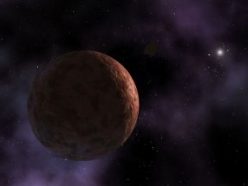Solving a Sedna Mystery
Astronomers are learning more about the most-remote object known in the solar system.
By Emily Sohn
Orbiting beyond Pluto, a planetoid called Sedna has aroused plenty of curiosity—and created some confusion—since its discovery last year. It’s the most-remote object known in the solar system.
 |
|
Does the recently discovered planetoid Sedna, shown in this artist’s impression, have a moon?
|
| NASA/JPL-Caltech |
Astronomers have been especially frustrated by their inability to find a moon around the distant object. The first observations had suggested that there ought to be one.
These observations appeared to show that Sedna spins very slowly, just once every 20 days. Only the tug of a little moon could explain this lazy spin rate. Images taken by the Hubble Space Telescope, however, failed to turn up a moon.
Now, researchers from the Harvard-Smithsonian Center for Astrophysics in Cambridge, Mass., say they have solved the puzzle. New measurements show that Sedna doesn’t spin so slowly after all.
Using a highly sensitive telescope on Mount Hopkins in Arizona, the astronomers measured periods of brightness and darkness on Sedna. The results showed that the planetoid spins some 50 times faster than previous estimates had suggested.
Elsewhere, researchers turned up other interesting news about Sedna. Contrary to earlier assumptions, they found that Sedna doesn’t appear to have any ice on its surface.
That’s strange because it’s very cold so far away from the sun. And Pluto, which is closer to the sun, has lots of ice on it. So does Pluto’s moon, Charon.
The explanation for this mystery, the scientists suggest, is that Sedna used to have an icy surface. However, constant bombardment by cosmic rays and the sun’s ultraviolet light produced a dark coating instead.
Because Pluto and Charon orbit closer to the sun than Sedna, they might encounter more debris than Sedna does. Frequent collisions with this debris could then either prevent a dark coating from forming or deliver fresh ice to their surfaces.—E. Sohn
Going Deeper:
Cowen, Ron. 2005. Far-out science. Science News 167(April 30):286. Available at http://www.sciencenews.org/articles/20050430/note15.asp .
Sohn, Emily. 2004. Search for a missing moon. Science News for Kids (April 28). Available at http://www.sciencenewsforkids.org/articles/20040428/Note3.asp .
_____. 2004. Planets on the edge. Science News for Kids (April 7). Available at http://www.sciencenewsforkids.org/articles/20040407/Feature1.asp .
For additional information about Sedna, go to sse.jpl.nasa.gov/scitech/display.cfm?ST_ID=105 (NASA Jet Propulsion Laboratory).







